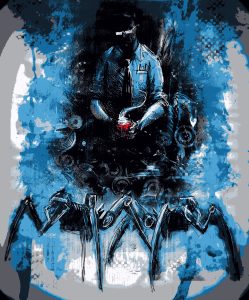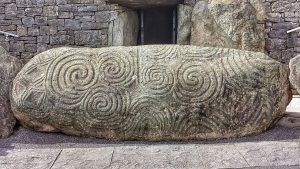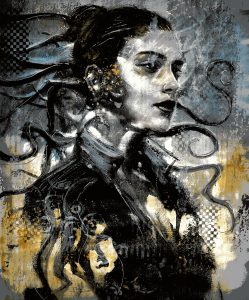An essay by Professor Caldwell Mook, as provided by Nick Morrish
Art by Luke Spooner
I was recently the recipient of a sizeable bequest from Sir Blumquist Plimpington, a speculative microbiologist with whom I worked during the Manhattan Frog Pox outbreak of the early nineties. Although I was not directly involved with his virus containment efforts, I did assist in the subsequent cover-up when it was unmasked as a hoax, designed to part the good people of Wall Street from their dubiously earned cash.
I was of course delighted to receive such a large sum of money from a man who I remembered with much fondness and suspicion. Somewhat ironically, Sir Blumquist died from Irritable Parrot Fever, which had long been thought to be an imaginary ailment. His will, therefore, specified that this particular bequest should be spent exclusively on research into disease prevention. True to his instructions, I began investigating the major causes of the transmission of infectious disease, which can be broken down into the following categories:
- Contact
- Food Contamination
- Insect Bites
- Foreign Travel
- Extra-Terrestrial Experimentation
- Television Medical Documentaries
After much consultation with experts in the field, I quickly determined that items five and six were most likely figments of a paranoid imagination and concentrated my efforts on the remaining four.
As I’m sure you are aware, I conduct most of my work in northern England. At that latitude, insect-borne diseases such as malaria and Dengue fever are virtually unknown. I, therefore, felt poorly qualified to investigate item three. The only way I might have researched this issue would have been to combine it with item four. However, I decided journeying to the mosquito-infested tropics was a step too far, even though Sir Blumquist’s funds would have enabled me to travel first class.
Item two, food contamination, was an obvious concern, especially as much of it now comes from abroad, where it is almost certainly grown in dirty fields filled with bugs and without the modern conveniences of insecticides, herbicides, and fungicides. I, therefore, decided to investigate this aspect of infection control by baking or boiling all my food for several hours before consumption. This does compromise the flavor, consistency, and nutritional value of many food items, particularly soft fruit and bread products. However, in my student days, I survived perfectly well on a diet of pizza and vitamin pills, and thought it well worth the inconvenience to prevent any possible contaminants reaching my digestive system.
This left item one, infection via contact, as the prime focus of my investigations. I decided I need to research both direct and indirect contact, and it soon struck me that one could disinfect two birds with one radiation source, so to speak. The mechanism common to all contact is of course touch–whether that be kissing, sneezing, scratching, or opening the door to a doctor’s waiting room. It seemed to me that much of this was unnecessary and should be avoided or even banned, in the interests of public health.

“This is where you sit to control the robots and that Van Der Graaf generator thing over there. Not sure what it does, but we automated it anyway. Hope you don’t mind?”
To read the rest of this story, check out the Mad Scientist Journal: Winter 2020 collection.
Professor Caldwell Mook holds the Mithering Chair of General Negativity at the University of Leeds, England. He specializes in preemptive risk analyses for speculative technology. Professor Mook regularly offers discouragement and derision to scientists and engineers around the world.
Nick Morrish is an increasingly mad engineer who lives in Hampshire, England, where his eccentricities are considered quite normal. He clings to the last vestiges of sanity by writing serious and truthful stories about the nature of existence. Since no one else seems to observe truth in quite the same way, his work is often mistaken for satire and fantasy.
Luke Spooner, a.k.a. ‘Carrion House,’ currently lives and works in the South of England. Having recently graduated from the University of Portsmouth with a first class degree, he is now a full time illustrator for just about any project that piques his interest. Despite regular forays into children’s books and fairy tales, his true love lies in anything macabre, melancholy, or dark in nature and essence. He believes that the job of putting someone else’s words into a visual form, to accompany and support their text, is a massive responsibility, as well as being something he truly treasures. You can visit his web site at www.carrionhouse.com.
“Do Not Touch” is © 2019 Nick Morrish
Art accompanying story is © 2019 Luke Spooner





 There are a couple of cool comic book projects we’ve got our eyes on at Kickstarter right now!
There are a couple of cool comic book projects we’ve got our eyes on at Kickstarter right now!
